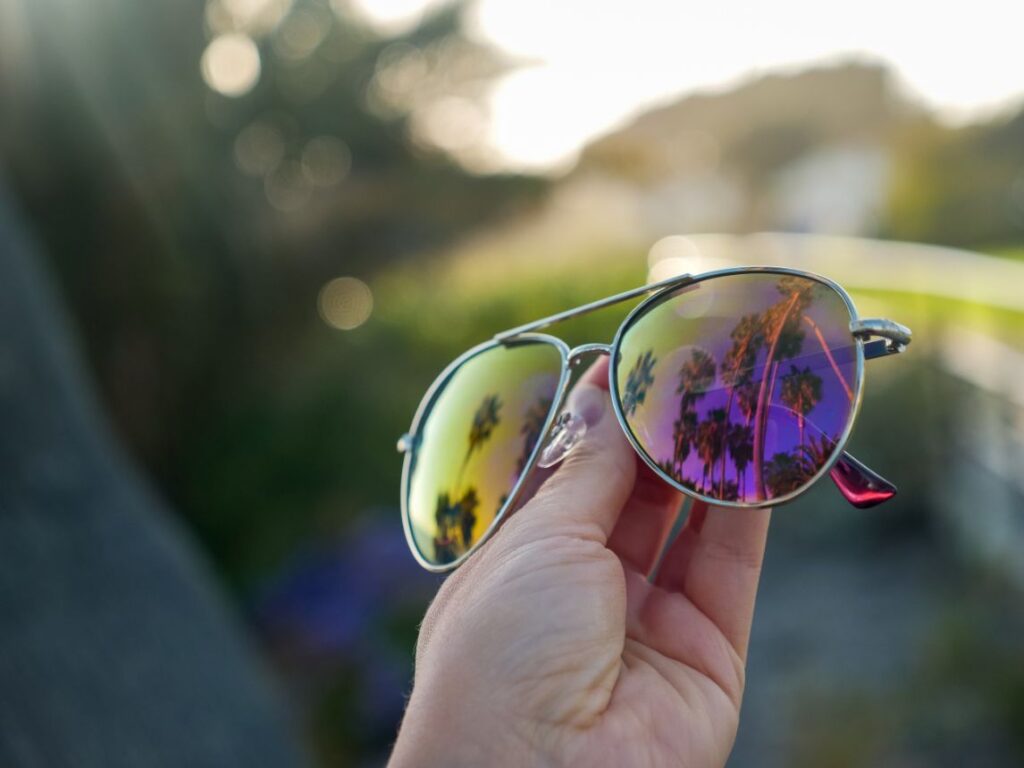A crucial decision must be made when selecting sunglasses. We have given you a lot of information about polarized sunglasses, including what they are, how they work, what advantages and disadvantages they have, how to choose a pair, etc.
Polarized sunglasses reduce glare from reflective materials like glass, snow, and water. Glare alters an object’s true color and makes it more difficult to see it. In any circumstance where it’s important to see clearly and stay safe, polarized sunglasses can be useful.
Glare can be hazardous, particularly when you’re driving. Sun glare has been associated with other traffic accidents and pedestrian fatalities. The function of polarized lenses is described in this article. Additionally, some of the advantages and disadvantages of this type of eyewear are described.
What Are Polarized Sunglasses?
As a result of a chemical process applied to the lenses, polarized sunglasses filter light. This chemical mixture’s molecules are arranged in such a way that they prevent some light from passing through.
You’re not completely blocking out the light, but rather letting through just enough to give you a good field of vision. The contrast will be a little bit darker, but the images you see will still be very clear.

It can get very tiring very quickly to deal with the sun’s glare. If you’re driving, hiking, boating, fishing, or just lounging on the beach, switching to a pair of polarized sunglasses is ideal.
Polarized glasses can aid in protecting your field of vision and your eyes while skiing or snowboarding outside in the winter.
Both prescription and non-prescription eyewear, as well as transition lenses, can use polarized lenses. All types of people, including those who are extremely sensitive to light, those who have recently undergone cataract surgery, and those who frequently spend time in direct sunlight, can benefit from them.
Wearing polarized glasses not only keeps you safe when glare is a possibility, but it also safeguards the health of your eyes. When going outside, it is advised that you wear sunscreen to protect your skin from UV rays. If your eyes are not shielded, these same UV rays can harm them.
Of course, polarized glasses aren’t always advantageous. Wearing them while looking at your phone, car dashboard, or ATM machine may impair your vision.
Polarized lenses would only make glare less useful in situations where it might otherwise be useful. If you’re trying to see ice on the road or are driving at night, glare can be useful.
What Does “polarized” Mean?
A polarized lens has a built-in filter that blocks bright, reflected light. This intense light is known as glare. Glare reduction makes your eyes more at ease and improves your ability to see your surroundings.

The sun’s rays are dispersed everywhere. However, when light hits flat surfaces, it has a tendency to become polarized, which causes the reflected rays to travel in a more consistent (typically horizontal) direction. This produces a light intensity that can be unpleasant and even dangerous, which can make it harder to see.
What Do Polarized Sunglasses Do?
Polarized sunglasses can improve your vision, but they don’t do any more to shield your eyes from UV rays than regular UV lenses.
They accomplish this by obstructing horizontal light waves, the kind that most surfaces reflect and cause glare. The filter in these lenses only lets through vertical waves.
Polarized lenses:
- Increase your visual comfort
- Sharpen the contrast between light and dark
- Allow you to see true colors
- Help prevent eye strain and fatigue
There are numerous color options for polarized lenses. The material used to make the lenses determines how dark or light they are. Gray and brown are the most typical colors, but other hues like green and yellow, and melanin are also widely used.
Stronger effects are typically produced by darker hues.
What’s the Difference Between Polarized & Non-Polarized Lenses?

Because light moves in waves, it vibrates. Light usually vibrates in several directions. But light only vibrates in one direction, horizontally, when it hits a horizontal surface like snow, water, or the roof of a car. Polarization describes this process.
The light is concentrated and strikes the eye directly because it only vibrates in one direction. We call this concentrated light, “glare.”
The way polarized and non-polarized lenses deal with glare is what makes them different from one another.
Non-polarized Lenses
Sunglasses without polarization are made to lessen all light’s intensity. If your lenses claim to provide UV protection, they almost certainly contain unique dyes and pigments that bind to ultraviolet rays and block them from reaching your eyes.
But regardless of the direction, the light vibrates in, this technology operates in the same way for all types of sunlight. As a result, glare will continue to have an impact on your vision by striking your eyes with greater intensity than other light.
Polarized Lenses
A substance that blocks light is used to treat polarized lenses. However, because the filter is applied vertically, the only light that is traveling vertically can pass through.
Consider a picket fence with an inch between each slat as an example. If you held a popsicle stick vertically, you could easily slip it between the slats. The popsicle stick won’t fit between the fence slats if you turn it horizontally.

That is the basic concept behind polarized lenses. The filter allows some vertical light to pass through but not glare or horizontal light.
How to Tell If Sunglasses Are Polarized?
When you pull out an old pair of sunglasses or go shopping, you might be curious about whether they are polarized. Holding your sunglasses in front of your face allows you to quickly check them.
Examine something like a computer or smartphone screen through the lenses. You might see a change in the image or a change in the brightness of the image you’re looking at as you move your glasses up and down or left and right.
This would suggest that you are using polarized lenses to view the world. You most likely have tinted lenses if you don’t notice a difference in the quality of the image you’re viewing.
You can use both of your pairs of glasses to check for polarization if you have two. To see through both glasses, place one directly in front of the other.
Set up a right angle with the glasses by shifting one of the pairs. If you wore two pairs of polarized glasses, the lenses would merge and give the impression of being completely black.
Should You Wear Polarized Sunglasses Or Just a Tint?
When buyers are worried about harmful sunlight and glare, polarization is unquestionably the best option. A portion of the population, though, is simply unable to wear polarized lenses. They just can’t stand wearing them, regardless of whether it’s psychological or neurological.
It makes them disoriented, and dizzy and some people say they feel like everything appears to look more “3-dimensional.” These individuals might benefit more from a lens tint that has glare-free technology applied to the back of the lens.
A worker may need to be able to read specific digital numbers on an LCD device for a few different occupations. The visibility of the numbers on these devices can occasionally be hampered by polarized lenses.
You Might Also Like: Are Polarized Sunglasses Better?
Pros and Cons of Polarized Sunglasses

It’s time to weigh the benefits and drawbacks of this type of sunglass after learning a little more about what polarized sunglasses are and what they offer. The benefits and drawbacks of purchasing a pair of polarized sunglasses will be discussed in this chapter.
Pros
A pair of sunglasses with polarized lenses are a wise investment because they offer a variety of advantages. As an illustration, polarized lenses improve visual comfort for your eyes by minimizing glare.
Even when it’s very bright outside, you’ll be able to see images more clearly. Polarized sunglasses can also help you see more clearly and in greater contrast. When you are wearing polarized lenses, everything generally looks much clearer.
Eye strain can occur when you are subjecting your eyes to glare. You cannot adequately protect your eyes, not even with standard non-polarized sunglasses. You should take great care not to put any additional strain on your eyes.
When light strikes a surface, such as the ground, and bounces back up to your eyes, glare results. Your vision will be obstructed by this. Refractive errors of vision can be fixed by your polarized sunglasses.
Cons
Not always is wearing polarized sunglasses the best choice. Before deciding what you want to invest in, there are some drawbacks to take into account.
This can make it challenging to see objects like LCD screens when wearing polarized sunglasses. Polarized lenses can make it uncomfortable to use your phone when you’re outside frequently. Another possibility is that you will have trouble seeing the infotainment screen in your car.
It would also be unclear on an ATM screen. Because of this, many professions actually forbid the wearing of polarized sunglasses. Non-polarized lenses are required for pilots and heavy equipment operators.
People who frequently go skiing or snowboarding shouldn’t use polarized lenses. You must be able to identify any icy patches that might endanger your safety when you are out on the hill. It would be a better idea to select non-polarized glasses or goggles.
Polarized lenses are more expensive to purchase if you’re on a tight budget. Some individuals believe that this investment is essential. Maybe you don’t feel the same way.
Conclusion: Finding the Right Polarized Sunglasses
Make an appointment for an eye exam to get started on getting the best vision with polarized lenses.
Prescription polarized sunglasses will help you see as clearly and comfortably as possible during the day if you have even a slight refractive error.
Since you are now an authority on polarized sunglasses, we urge you to educate others who also need sunglasses. Many people find success with this option for eye protection.

